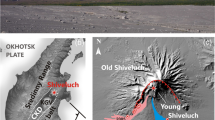Conclusions
We find no support for the claim that the Skaergaard magma followed the trend of common tholeiitic volcanic magmas, such as those of Iceland and the Scottish Tertiary. The end product of differentiation was not a large mass of rhyolite but an iron-rich, silica-poor liquid not unlike that deduced by Wager in 1960.
The proposal that a large mass of rhyolitic liquid occupied the upper levels of the intrusion finds no support in the field. The thick series of ferrogabbos, which became richer in iron and poorer in silica until they reached a field of immiscibility cannot be reconciled with crystallization of a large mass of felsic magma. Mass-balance calculations that indicate otherwise are invalid, because they fail to take into account large volumes of rocks that differ in composition from those assumed in the calculations.
While ignoring the existence of major units of the intrusion, Hunter and Sparks propose that lavas in Scotland and Iceland are more relevant to the liquid compositions than rocks that are intimately associated with the intrusion. Their argument that the Skaergaard Intrusion followed a trend of silica enrichment that is universal to tholeiitic magmas is based on an incomplete knowledge of the rocks and faulty calculations of mass-balance relations.
We agree that much remains to be learned about the Skaergaard Intrusion and the basic mechanisms of magmatic differentiation. In this case, however, we are ready to hang our case on well-established field relations and a mass of laboratory data for what must be the most intensely studied body of rock on Earth.
Similar content being viewed by others
References
Brooks CK, Nielsen TFD (1978) Early stages in the differentiation of the Skaergaard magma as revealed by a closely related suite of dike rocks. Lithos 11:1–11
Henderson P (1970) The significance of the mesostasis of basic layered igneous rocks. J Petrol 11:463–473
Hoover JD (1989) Petrology of the marginal borders series of the Skaergaard Intrusion, East Greenland. J Petrol 30:399–439
Hoover JD (1989) The chilled marginal gabbro and other contact rocks of the Skaegaard Intrusion. J Petrol 30:441–476
Hunter RH, Sparks RSJ (1987) The differentiation of the Skaergaard Intrusion. Contrib Mineral Petrol 95:451–461
McBirney AR (1975) Differentiation of the Skaergaard intrusion. Nature 253:691–694
McBirney AR (1989) The Skaergaard Layered Series: I — Structure and average compositions. J Petrol 30:363–397
McBirney AR, Nakamura Y (1973) Immiscibility in late-stage magmas of the Skaergaard intrusion. Carnegie Inst Washington Yearb 72:348–352
Morse SA, Lindsley DH, Williams RJ (1980) Concerning intensive parameters in the Skaergaard Intrusion. Am J Sci 280-A:159–170
Naslund HR (1983) The effect of oxygen fugacity on liquid immiscibility in iron-bearing silicate melts. Am J Sci 283:1034–1059
Naslund HR (1984) Petrology of the Upper Border Series of the Skaergaard Intrusion. J Petrol 25:185–212
Park CF (1961) A magnetite “flow” in northern Chile. Econ Geol 56:431–436
Wager LR (1960) The major element variation of the Layered Series of the Skaergaard intrusion and a re-estimation of the average composition of the hidden Layered Series and of successive residual magmas. J Petrol 1:364–398
Wager LR, Brown GM (1968) Layered Igneous Rocks. Oliver and Boyd, Edinburgh, London, 588 p
Wager LR, Deer WA (1939) Geological investigations in East Greenland, Part III. The Petrology of the Skaergaard Intrusion, Kangerdlugssuaq. East Greenland. Meddr Gronland 105:1–352
Williams RJ (1971) Reaction constants in the system Fe−MgO−SiO2 O2: intensive parameners in the Skaergaard Intrusion, East Greenland. Am J Sci 271:132–146
Author information
Authors and Affiliations
Rights and permissions
About this article
Cite this article
McBirney, A.R., Naslund, H.R. The differentiation of the Skaergaard Intrusion. Contr. Mineral. and Petrol. 104, 235–240 (1990). https://doi.org/10.1007/BF00306446
Accepted:
Issue Date:
DOI: https://doi.org/10.1007/BF00306446




